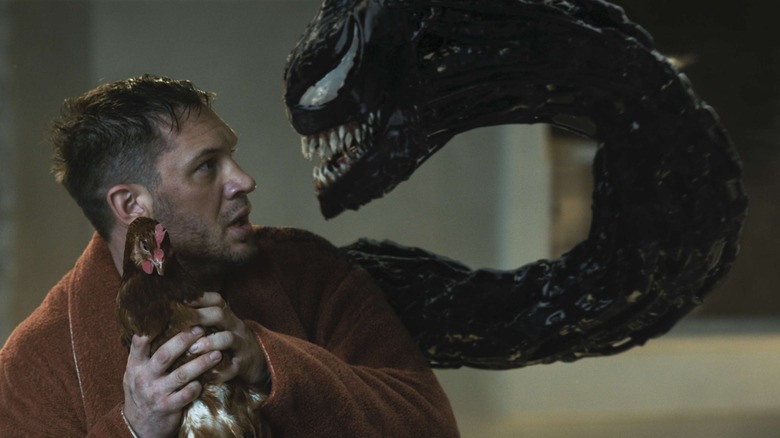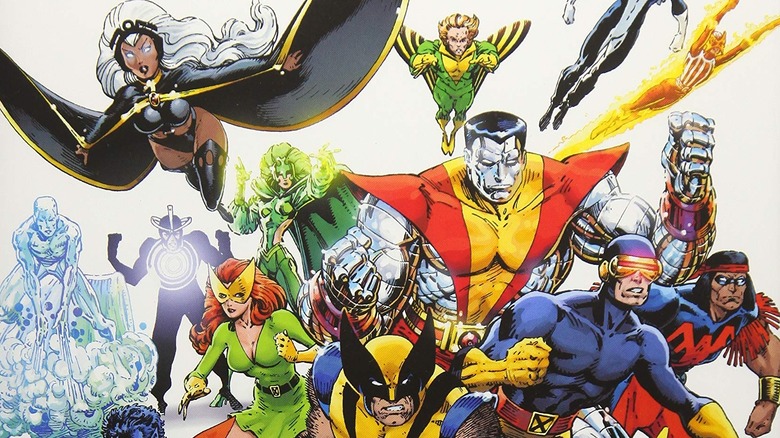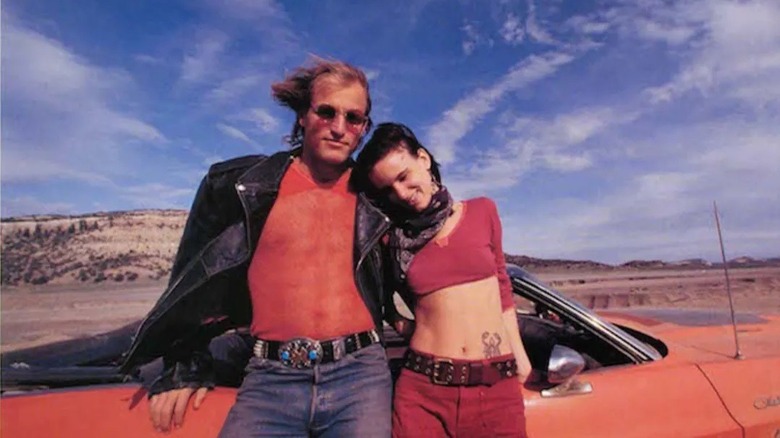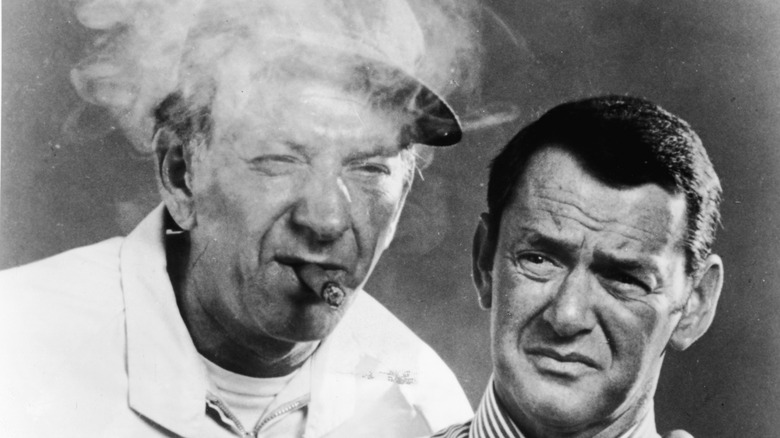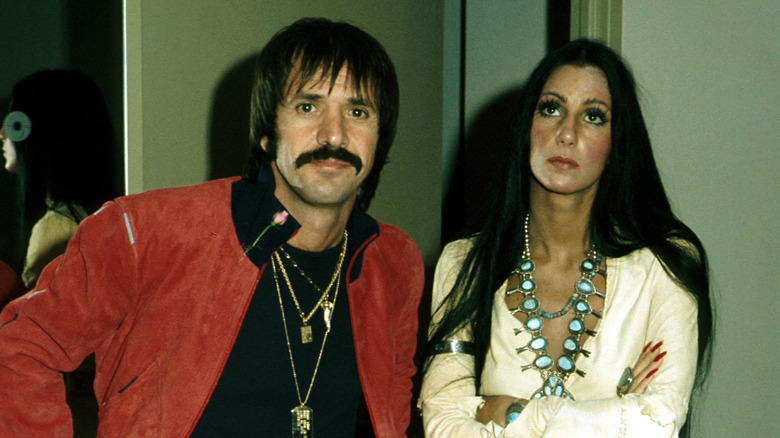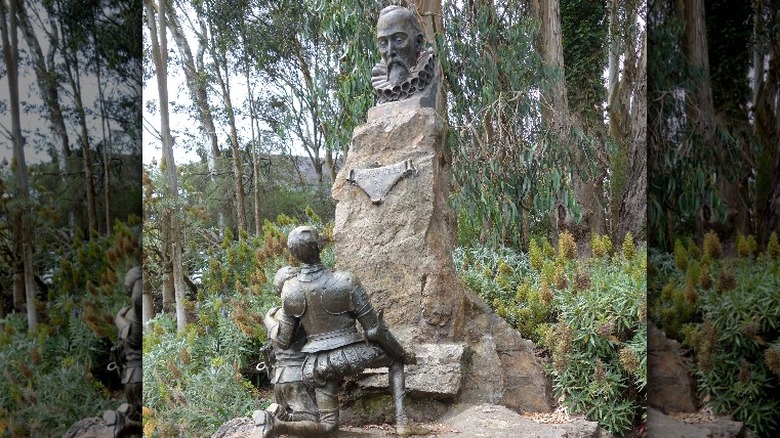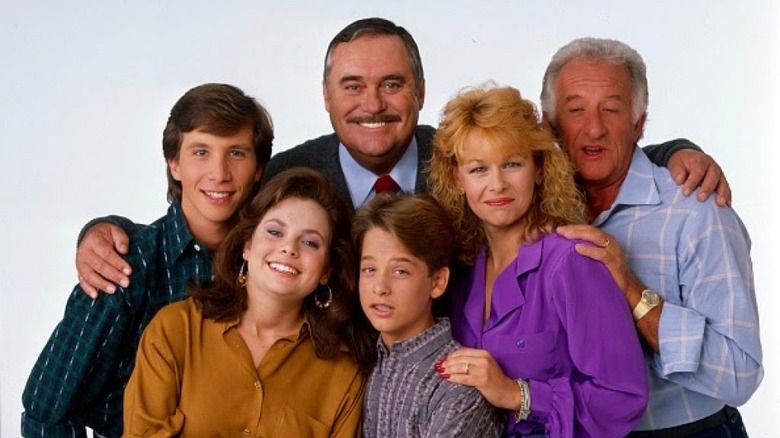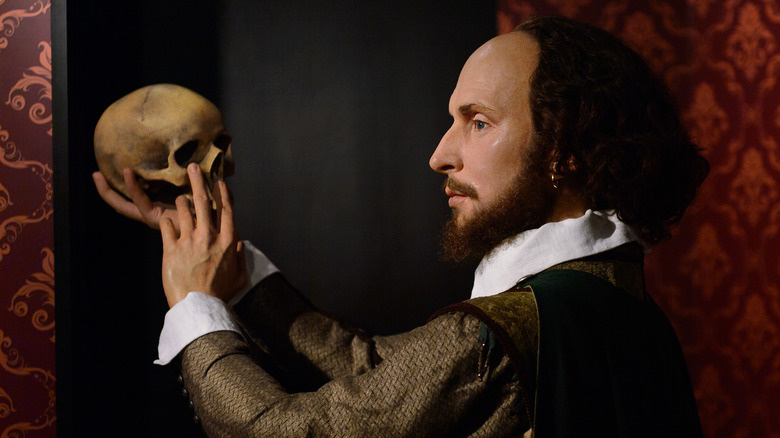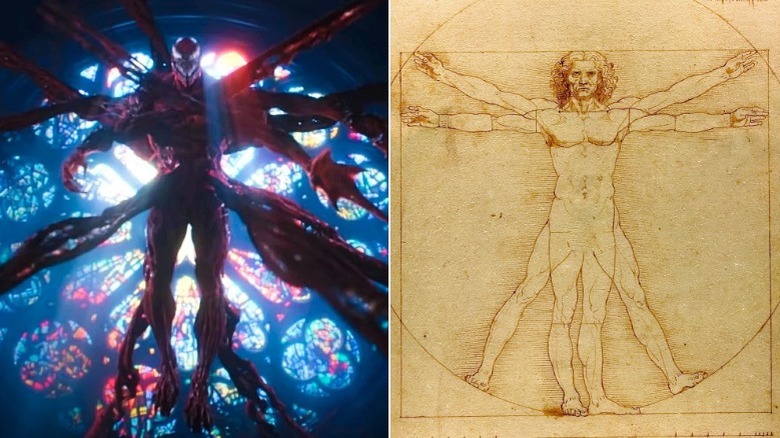Things Only Adults Notice In Venom: Let There Be Carnage
Sony's latest symbiote film, "Venom: Let There Be Carnage," takes viewers on a wild ride with a loaded cast. Under the direction of motion-capture legend Andy Serkis, and starring Woody Harrelson as the villainous Celtus Cassidy/Carnage, Naomie Harris as his lifelong love Francis Barrison (also known as the mutant Shriek), and (of course) Tom Hardy as Eddie Brock/Venom, this film should have been a huge hit with audiences. Unfortunately, its PG-13 rating and zany energy make it come across as far too cartoonish and over-the-top to older audiences. That's clearly evidenced by its lackluster 60% rating on Rotten Tomatoes.
Despite its flaws, "Let There Be Carnage" is a fun movie with genuine laugh-out-loud moments, and it's certainly not the worst way to spend an hour and 30 some-odd minutes. There are also some pivotal MCU moments layered into the silliness that shouldn't be missed by Marvel fans. It seems that MCU may, in fact, be bringing the once-feared "M" word back into its vocabulary, something fans have been dying to see for ages (and no, it's not "Muggle,"). This, and many other aspects of the film, might go over younger viewers' heads, but adults can't help but notice them like bright red flags. Here are all the things only older audience members are likely to notice in "Venom: Let There Be Carnage."
They finally said the 'M' word!
The MCU has produced some phenomenal content throughout the years, and it arguably gets better with each iteration. However, there are some pretty huge holes in the Marvel on-screen universe when it comes to the X-Men and Fantastic Four. In a desperate attempt to avoid bankruptcy back in the late '90s, Marvel sold the rights to those characters to Fox, along with the rights to Spider-Man to Sony Pictures. The MCU has been severely disjointed ever since, and fans have been perpetually disappointed by poorly constructed, sprawling X-Men and F4 films that are forced to stand apart from the MCU.
Under this deal, ironically, Marvel hasn't even been able to mention the words "mutant" or "mutation" in their films, compromising instead with MacGuffins like the Infinity Stones, which it's used to explain away the powers of characters like Scarlet Witch.
Within the first few minutes of "Let There Be Carnage," however, this taboo is quietly shattered, and older viewers took note. During a whispered conversation behind bars between a young Shriek and Cletus, she mentions that her "mutations are advancing," and she's being transferred to a place "with others like her." This makes Shriek the first character in the MCU to be officially affiliated with the once-dreaded "M" word. This has older fans hoping there will be more mutants coming to Marvel films and series in the near future. Considering the fact that Disney now owns Fox and Marvel, the mutant possibilities are endless.
Natural Born Killers
Part of the plot in "Let There Be Carnage" revolves around the relationship between Cletus and his "shining light," Frances Barrison, ultimately known as "Shriek." The pair are two star-crossed lovers with traumatic backgrounds who go on a killing spree, and their foul deeds are subsequently and irresponsibly glorified by our violence-obsessed mass media. If this theme sounds familiar, that's because it is eerily similar to the plot of "Natural Born Killers," an Oliver Stone film following the mad lives of fictional psychopathic serial killers Mickey and Mallory Knox.
In fact, Woody Harrelson stars as the main villain in both movies, and the similarities between those roles are hard to miss for viewers who have seen the two films. After all, there's something darkly intoxicating about true love between psychopaths, and the concept makes for a fascinating one to examine on-screen.
This is especially true when you have a powerhouse actor like Harrelson behind the character, who seems to have worked the philosophical psycho-in-love thing down to a science. Although Naomie Harris shines as Shriek in "Carnage," it's hard to top the chemistry shared between Harrelson as Mickey and Juliette Lewis as Mallory in "Killers," as is evident by the cult following glorifying their twisted love.
The Odd Couple
During the course of this film, Eddie Brock undergoes some serious disagreements with his not-so-better half, the alien symbiote Venom. To be fair, it must be incredibly challenging to live with an extraterrestrial creature with drastically different needs from your own. That's especially true when your other half is constantly trying to eat people. The domestic strife Eddie and Venom share in their San Francisco apartment may remind older viewers of "The Odd Couple," a popular American play by Neil Simon that inspired both a 1968 film and 1970 TV series of the same title.
In all its iterations, "The Odd Couple" was a comedy centering around neurotic neat-freak Felix Ungar and fun-loving slob Oscar Madison, who decide to live together after each man gets divorced. Antics ensue as a result of these opposites attempting to cohabitate. Adults who are familiar with the concept can see the similarities between Eddie and Venom, with Eddie naturally being Felix and Venom being the rather wilder Oscar — well, if Oscar was obsessed with chowing down on brains and chocolate.
Sonny and Cher
Speaking of brains, Venom acquires a pair of chickens in his quest to cure his craving for grey matter. However, after spending time with his feathered companions, he becomes too attached to the birds to eat them. Venom names his new pets "Sonny" and "Cher," which just about any adult watching will know is a reference to the classic American pop duo with the same monikers. During the '60s and '70s, husband and wife team Sonny Bono and Cher danced and sang their way into fans' hearts all over the world with hits like, "I Got You Babe," "Little Man," and "The Beat Goes On."
The dynamic duo became so popular that they were granted their own TV show in 1971, "The Sonny & Cher Comedy Hour," which revolved around their relationship and concluded with them singing to each other at the close of each show. Unfortunately, their picture-perfect relationship was slowly crumbling behind the scenes, but the two maintained an outward appearance that all was well for the sake of their intertwined careers.
Sonny and Cher wound up filing for divorce in 1975. Unfortunately (but understandably), the magic they'd shared creatively fizzled after that. Knowing this background makes Venom's choice of names for his pet chickens both a funny and surprisingly poignant selection, especially when contrasted against the strife that builds between Venom and Eddie in this film.
Man cannot live on chocolate alone
In "Venom: Let There Be Carnage," Eddie has developed a deal for bulk chocolate orders with Mrs. Chen, the local, sassy convenience store owner who is in on his dirty little secret. Venom explains he needs massive amounts of chocolate (and brains) because they are the only sources of phenylethylamine (PEA for short), a natural alkaloid that the symbiote needs to survive. This compound has also been shown to boost mood in humans in real-life studies. However, these studies have also shown that PEA can be found in an abundance of other food sources, including raw lentils, beans, nuts, and seeds, as well as raw meat, seafood, poultry, and eggs. Adults with a background in nutrition or interest in healthy eating may have already quirked an eyebrow at Venom's weak defense of his diet by that point in the film.
Surprisingly, clinical studies have shown that blue-green algae has some of the highest PEA content out of any food sources currently available. So, instead of Venom gorging on chickens and chocolate, he could have been eating a variety of raw protein and algae to fulfill his needs. In fact, he could have even been on a vegan diet if he'd really wanted to avoid all the trouble of breaking into chicken coops and coughing up feathers.
Marvel meets literary history
After Venom and Eddie go through their quintessential mid-film break-up, Eddie enjoys his newfound peace by deep-cleaning his apartment and patching up symbiote-sized holes in his ceiling. He also relocates resident chickens, Sonny and Cher, to the Golden Gate State Park, where they can free-range roam and eat to their little hearts' content. When the camera cuts to this particular scene, it starts off with an extreme closeup of a statue of Miguel de Cervantes, a Spanish author most famous for penning the 17th-century novel "Don Quixote."
Perceptive viewers with a penchant for European literature might notice some parallels between Cervantes's classic tale and "Let There Be Carnage," and thus understand Andy Serkis's desire to rather blatantly include this statue in his film. Originally published by Cervantes in 1605 and 1615, "Don Quixote" is a parody of the chivalric romances that were popular during that time. It follows the adventures of an aging knight who becomes overly absorbed in the romances he reads and decides to leave his real life in search of fantastical adventures.
Along the way, he meets a peasant named Sancho Panza, who becomes his sidekick and "squire." Now, on the surface, the story of Don Quixote and Eddie Brock/Venom may seem very different, but don't discard the notion too quickly. Underneath they're ultimately both comedic adventures about odd couples who try to save the day — but always end up making a silly mess of things in the process.
Eddie and Anne's cat's name references an 80's sitcom
Eddie's ex-fiance, Anne Weying, has a pet cat named "Mr. Belvedere," who is mentioned briefly in both Venom movies. Somewhat older viewers will know the inspiration for this moniker stems from a 1985 American sitcom by the same name, which is all about a proper English housekeeper who's tasked with caring for a more casual American family. The series was based on Lynn Aloysius Belvedere, a character originally created by author Gwen Davenport for her 1947 novel "Belvedere."
Mr. Belvedere's unflappable wit and practicality in the face of various sitcom antics soon made him a beloved character. Davenport's novel was adapted into a 1948 comedic film, "Sitting Pretty," before later being made into an '80s sitcom. The show was as touching as it was funny, thanks in part to the cast powering each episode.
Christopher Hewitt starred as the incomparable Mr. Belvedere, Rob Stone played father Kevin Owens, who later starred as Lewis Skolnick in "Revenge of the Nerds," and former Major Leaguer-turned-actor, Bob Uecker, as grandpa George Owens. Considering cats can be incredibly prim and proper (and often seem to manage the people in their households, rather than the other way around), Mr. Belvedere makes a great name for a pet cat in a movie like "Venom: Let There Be Carnage."
'Something wicked this way comes'
Cletus spits out many philosophical-sounding lines throughout the course of this film, right up until what seem to be his final moments. To everyone's surprise, however (including his own) the lethal injection he's been given doesn't work as planned. Instead, Cletus became an unwitting host of the alien symbiote when he bit Eddie's hand during his final pre-execution interview. Instead of sending him into oblivion, the dose triggers the symbiote that will become known as Carnage, causing his body to reject the killer drug cocktail.
As Cletus watches these odd events unfold, he says ominously, "Something wicked this way comes." This line might go over many younger viewers' heads, or at the very least make them think of the creepy song from "Harry Potter and the Prisoner of Azkaban." However, adults will likely recognize the quote from its original source: William Shakespeare's classic tragedy, "Macbeth."
In Shakespeare's play, the line is spoken by a trio of witches who act as some of the plot's primary antagonists. They push Macbeth down a path of treachery, paranoia, and towards his ultimate downfall. As Celtus becomes twisted by Carnage's destruction, Macbeth becomes so corrupt in his quest for power he is no longer recognizable. So, when the witches foresee his arrival in Act 4, Scene 1, they no longer refer to him as a person, saying, "By the pricking of my thumbs/Something wicked this way comes" — an interesting connection between classic literature and the latest Venom film.
The man in black
After Cletus's failed lethal injection triggers Carnage, he does what any convicted killer would probably do, using his newfound powers to break out of prison and wreak as much destruction as possible in the process. Once outside San Quentin State Prison, Cletus casually strolls down the road while singing to himself, "And I'll walk out a wiser, stronger man. Mister Warden, you taste just like ham." Obviously, Cletus does not set the same ground rules for his symbiote as Eddie (although controlling Carnage in any way is probably unlikely for even the best-intentioned host).
What may be less obvious, especially to younger viewers, is that those dark lyrics are a take on country singer Johnny Cash's famous song, "San Quentin." It's a ballad of sorts for the disenfranchised and incarcerated, an artistic bent that brought a lot of credibility and fame to its singer. Cash clearly had a soft spot for those behind bars and performed at several prisons throughout his career, including Tennessee State, Folsom Prison, Österåker Prison in Sweden, and, of course, California's San Quentin. One can't help but wonder how Carnage would have treated the Man in Black had they crossed paths — hopefully, Cash's soulful tunes would have soothed the savage beast long enough for him to get away.
The Vitruvian Man
The final showdown between Venom and Carnage takes place in a cathedral, during which there is a picture-perfect moment when Carnage is framed by a stained-glass window with his many limbs outstretched. Adult viewers will know this is more than just a pretty visual. It's actually an homage to Leonardo Da Vinci's "Vitruvian Man" — a drawing of a nude man with arms and legs outstretched in two positions, framed by a circle inside a square. In fact, VFX Supervisor Sheena Duggal referred to Venom as being "like the Vitruvian Man" when describing his unique physical characteristics to Snap Taste.
Da Vinci finished the drawing around 1490, in an attempt to illustrate the principles of the Roman architect Marcus Vitruvius. This ancient engineer idealized the proportions of the human body and attempted to translate them into architecture. The shapes in Da Vinci's drawing represent more than meets the eye, as these classical scientists often incorporated symbolism into their equations.
The circle around the "Vitruvian Man" represents the "cosmic and divine," while the square stands for that which is "earth and secular." By imposing the human form onto these shapes, artists and polymaths like Da Vinci were showing others how humans can fit into both of these worlds and thus could serve as a way to study the underlying structure of the very universe. Didn't think you'd get all that in-depth analysis out of a silly comic book movie, did you?
